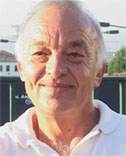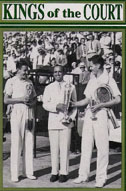Lew Hoad:
The Greatest Speed and Strength
By Ed Atkinson
Lew Hoad possessed the greatest combination of speed and strength tennis has ever seen. An exaggeration? Watch the video clips and see for yourself.
At 10 years of age, he was slightly built but could easily handle the racquet with one hand on the backhand side, and had a perfect technical serve. Hoad had everything. A huge first serve. Great volleys. He returned first serves for winners. A technically, perfect game.
Hoad could simply do things with a tennis ball no one else could do. He just looked different: stronger, faster, but always graceful. And in the view of his rivals and contemporaries, as nice a guy as ever walked on the court. With his movie-star good looks and outgoing personality, Hoad became a tennis icon in the 1950s.
Jack Kramer described his game this way: "He was the only player I ever saw who could stand six or seven feet behind the baseline and snap the ball back hard, crosscourt. He'd try for winners off everything, off great serves, off tricky short balls, off low volleys. He hit hard overspin drives, and there was no way you could ever get him to temporize on important points."
In 1956 he won the first three stages of the Grand Slam, losing only to Ken Rosewall in a stunning upset in the finals of the U.S. Championships at Forrest Hills. Hoad and Bjorn Borg were probably the two greatest players never to win the American title.
Hoad turned professional after winning his second successive Wimbledon singles title in 1957. His first year as a pro was a series of head-to-head matches with the reigning king of professional tennis, Pancho Gonzales. Hoad won 18 of the first 27 matches, but Gonzales surged back to finally defeat Hoad by 51 matches to 36.
 |
A tennis icon with movie star looks. |
Gonzales, never a modest man, believed that: "Lew was the only guy who, if I was playing my best tennis, could still beat me."
"I think his game was the best game ever. Better than mine. He was capable of making more shots than anybody. Both volleys were great. His overhead was enormous. He had the most natural tennis mind with the most natural tennis physique."
Hoad was a member of the Australian team that between 1952 and 1956 won the Davis Cup four times. He is often remembered for his match as a 19-year-old amateur in the 1953 Davis Cup against the great United States champion Tony Trabert. In a titanic struggle, Hoad defeated Trabert by a score of 13-11, 6-3, 3-6, 2-6, 7-5 to help his country retain the Cup.
According to Rod Laver: "Lew Hoad, was my idol. I emulated most everything he did, on and off the court."
"There was no stronger tennis player in the world than Lew. He could serve at any speed he wanted. He had marvelous timing. He could, with virtually no backswing, hit a ball at any speed he wished."
"I developed my topspin backhand by watching Lew. I felt blessed that I
came along during his time."
As I recounted in my Rosewall article, I had the honor of personally
experiencing the full range of Hoad's talent in a tournament match at the Los Angeles
Tennis Club in 1956, when Hoad was at the height of his powers, and he and partner
Ken Roswall where the unidsputed doubles champions of the world. (Click Here.)
 |
At his best, the only player better than Gonzales, according to Pancho. |
Although my partner and I played better than we could have possibly
expected, we eventually succumbed 6-4, 6-3, after some incredible shot making by Lew Hoad
at key moments. Lew poached one of my returns and hit a swinging topspin backhand volley
for a winner. I tried to drill him with an overhead, one of my favorite plays in those days,
only to have him nearly take my head off with a reflex forehand volley.
Years later I ran into Hoad one evening at the casino in Monte Carlo. To my
amazement he asked if I remembered the match. "Lew, I can't remember every match I ever played,"
I managed to say with a straight face. There was a pause and then we both
broke out laughing.
Back problems plagued Hoad throughout his career and forced his retirement from
the tennis tour in the mid 1960s. In retirement, Hoad moved to Fuengirola, Spain, near Malaga,
where he and his tennis-playing wife, Jenny Staley, operated a tennis resort for more than
thirty years entertaining personal friends such as actors Sean Connery, Kirk Douglas, and
Charlton Heston. Lew Hoad was battling leukemia and waiting for a bone marrow donor when,
in his weakened condition, he died of a heart attack in 1994 at the age of 59.





